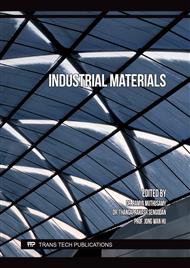[1]
X. Yi, H. Chen, H. Wang, C. Shi, J. Yang, The feasibility of using epoxy asphalt to recycle a mixture containing 100% reclaimed asphalt pavement (RAP), Constr. Build. Mater. 319 (2022) 126122. https://doi.org/10.1016/j.conbuildmat.2021.126122.
DOI: 10.1016/j.conbuildmat.2021.126122
Google Scholar
[2]
E. Haas, C.L. Ericson, T. Bennert, Laboratory designed hot mix asphalt mixtures with post-consumer Recycled Asphalt Shingles (RAS) utilizing AASHTO PP78, Constr. Build. Mater. 226 (2019) 662–672.
DOI: 10.1016/j.conbuildmat.2019.07.314
Google Scholar
[3]
H.F. Hassan, Recycling of municipal solid waste incinerator ash in hot-mix asphalt concrete, Constr. Build. Mater. 19 (2005) 91–98.
DOI: 10.1016/j.conbuildmat.2004.05.010
Google Scholar
[4]
A. Gedik, A review on the evaluation of the potential utilization of construction and demolition waste in hot mix asphalt pavements, Resour. Conserv. Recycl. 161 (2020) 104956. https://doi.org/10.1016/j.resconrec.2020.104956.
DOI: 10.1016/j.resconrec.2020.104956
Google Scholar
[5]
C.T. Chiu, Use of ground tire rubber in asphalt pavements: Field trial and evaluation in Taiwan, Resour. Conserv. Recycl. 52 (2008) 522–532.
DOI: 10.1016/j.resconrec.2007.06.006
Google Scholar
[6]
R. Haigh, Y. Bouras, M. Sandanayake, Z. Vrcelj, The mechanical performance of recycled cardboard kraft fibres within cement and concrete composites, Constr. Build. Mater. 317 (2022) 125920. https://doi.org/10.1016/j.conbuildmat.2021.125920.
DOI: 10.1016/j.conbuildmat.2021.125920
Google Scholar
[7]
Y. Ma, H. Zhou, X. Jiang, P. Polaczyk, R. Xiao, M. Zhang, B. Huang, The utilization of waste plastics in asphalt pavements: A review, Clean. Mater. 2 (2021) 100031. https://doi.org/10.1016/j.clema.2021.100031.
DOI: 10.1016/j.clema.2021.100031
Google Scholar
[8]
J. Choudhary, B. Kumar, A. Gupta, Utilization of Waste Glass Powder and Glass Composite Fillers in Asphalt Pavements, Adv. Civ. Eng. 2021 (2021) 17. https://doi.org/10.1155/2021/3235223.
DOI: 10.1155/2021/3235223
Google Scholar
[9]
N. Nciri, J. Kim, N. Kim, N. Cho, Investigation on the Chemical and Physical Properties of Vegetable Oil-Based Polyols for their Potential Application as Asphalt Rejuvenators, Key Eng. Mater. 723 (2016) 556–566.
DOI: 10.4028/www.scientific.net/kem.723.556
Google Scholar
[10]
N. Nciri, T. Shin, H. Lee, N. Cho, Potential of Waste Oyster Shells as a Novel Biofiller for Hot-Mix Asphalt, Appl. Sci. 8 (2018) 415.
DOI: 10.3390/app8030415
Google Scholar
[11]
N. Nciri, T. Shin, N. Kim, A. Caron, H. Ben Ismail, N. Cho, Towards the Use of Waste Pig Fat as a Novel Potential Bio-Based Rejuvenator for Recycled Asphalt Pavement, Materials 13 (2020) 1002.
DOI: 10.3390/ma13041002
Google Scholar
[12]
N. Nciri, T. Shin, N. Cho, Towards the Use of Waste Expanded Polystyrene as Potential Modifier for Flexible Road Pavements, Mater. Today: Proc. 24 (2020) 763–771.
DOI: 10.1016/j.matpr.2020.04.384
Google Scholar
[13]
N. Nciri, N. Kim, N. Cho, From Street to Road: An Innovative Approach to Explore Discarded Chewing Gum as a Performance-Enhancing Modifier for Road Pavement Applications, Polymers 13 (2021) (1963).
DOI: 10.3390/polym13121963
Google Scholar
[14]
N. Nciri, N. Kim, N. Cho, Spent Graphite from End-of-Life Lithium-Ion Batteries (LIBs) as a Promising Nanoadditive to Boost Road Pavement Performance, Materials 14 (2021) 7908.
DOI: 10.3390/ma14247908
Google Scholar
[15]
N. Nciri, N. Kim, A. Caron, Unlocking the Hidden Potential of Cosmetics Waste for Building Sustainable Green Pavements in the Future: A Case Study of Discarded Lipsticks, Molecules 27 (2022) 1697.
DOI: 10.3390/molecules27051697
Google Scholar
[16]
Ch. Chingakham, C. Tiwary, V. Sajith, Waste Animal Bone as a Novel Layered Heterogeneous Catalyst for the Transesterification of Biodiesel, Catal. Lett. 149 (2019) 1100–1110.
DOI: 10.1007/s10562-019-02696-9
Google Scholar
[17]
American Society of Testing Materials (ASTM) International. ASTM D546-17, Standard Test Method for Sieve Analysis of Mineral Filler for Asphalt Paving Mixtures; American Society of Testing Materials (ASTM) International: West Conshohocken, PA, USA, (2017).
DOI: 10.1002/ep.670180104
Google Scholar
[18]
X. Lu, U. Isacsson, Influence of styrene-butadiene-styrene polymer modification on bitumen viscosity, Fuel 76 (1997) 1353–1359.
DOI: 10.1016/s0016-2361(97)00144-0
Google Scholar
[19]
U. Isacsson, X. Lu, Characterization of bitumens modified with SEBS, EVA, and EBA polymers, J. Mater. Sci. 34 (1999) 3737–3745.
Google Scholar
[20]
X. Lu, Isacsson, U, Artificial aging of polymer modified bitumens, J. Appl. Polym. Sci. 76 (2000) 1811–1824.
DOI: 10.1002/(sici)1097-4628(20000620)76:12<1811::aid-app12>3.0.co;2-1
Google Scholar
[21]
American Society of Testing Materials (ASTM) International. ASTM D5/D5M-13, Standard Test Method for Penetration of Bituminous Materials; American Society of Testing Materials (ASTM) International: West Conshohocken, PA, USA, (2013).
DOI: 10.1002/ep.670180104
Google Scholar
[22]
American Society of Testing Materials (ASTM) International. ASTM D36/D36M-14e1, Standard Test Method for Softening Point of Bitumen (Ring-and-ball Apparatus); American Society of Testing Materials (ASTM) International: West Conshohocken, PA, USA, (2014).
DOI: 10.1002/ep.670180104
Google Scholar
[23]
American Society of Testing Materials (ASTM) International. ASTM D4402/D4402M-15, Standard Test Method for Viscosity Determination of Asphalt at Elevated Temperatures Using a Rotational Viscometer; American Society of Testing Materials (ASTM) International: West Conshohocken, PA, USA, (2015).
DOI: 10.1002/ep.670180104
Google Scholar
[24]
American Society of Testing Materials (ASTM) International. ASTM D113-17, Standard Test Method for Ductility of Asphalt Materials; American Society of Testing Materials (ASTM) International: West Conshohocken, PA, USA, (2017).
DOI: 10.1002/ep.670180104
Google Scholar
[25]
K. Bouiahya, A. Oulguidoum, A. Laghzizil, M. Shalabi, J.M. Nunzi, S. Masse, Hydrophobic chemical surface functionalization of hydroxyapatite nanoparticles for naphthalene removal, Colloids Surf. A: Physicochem. Eng. Asp. 595 (2020) 124706.
DOI: 10.1016/j.colsurfa.2020.124706
Google Scholar
[26]
M.M. Figueiredo, J.A.F. Gamelas, A.G. Martins, Characterization of Bone and Bone-Based Graft Materials Using FTIR Spectroscopy, in: T. Theophanides (Ed.), Infrared Spectroscopy- Life and Biomedical Sciences, IntechOpen, London, UK, 2012, p.315–338.
DOI: 10.5772/36379
Google Scholar



